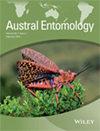The Ant Fauna of the Bo wen Basin, in the Semi‐arid Tropics of Central Queensland (Hymenoptera: Formicidae)
引用次数: 17
Abstract
A total of 96 species from 28 genera were recorded from a combination of pitfall trapping, baiting and hand collecting at five sites in the Bowen Basin region (mean annual rainfall about 600 mm) of central Queensland. The richest genera were Camponotus (15 species), Iridomyrmex (10), Melophorus (12), Monomorium (10), Pheidole (8), Meranoplus (6) and Polyrhachis (6). Twenty‐nine of the species have Eyrean affinities, 15 Torresian, and five Bassian, with the remaining 47 representing widespread taxa. Species turnover was very high across the sites sampled, with 69 (72%) recorded at only one site. Almost all the species that could be confidently named, including Myrmecia varians Mayr, Anochetus armstrongi McAreavey, Brachyponera lutea (Mayr), Iridomyrmexpurpureus (F. Smith), I. sanguineus Forel, Camponotus dromas Santschi, C. ephippium (F. Smith), C. whitei Wheeler, Opisthopsis pictus Emery, O. rufithorax Emery, Polyrhachis ammon (Fab.), P. senilis Forel, and P. trapezoidea Mayr, are widespread in northern or eastern Australia, but most of the other species (the majority) appear to have far more restricted distributions. The relative contributions of species by major genera were very similar to those found elsewhere in the Australian semi‐arid tropics, and, with the exception of Bassian genera, are also similar to those in the southern semi‐arid zone. These patterns are reflected in the biogeographic profiles and functional group composition of the various faunas. They point to a structurally rather uniform arid‐adapted fauna occurring throughout arid and semi‐arid Australia, with additional contributions by Torresian taxa in the north, and Bassian taxa in the south.昆士兰中部半干旱热带博温盆地蚂蚁区系(膜翅目:蚁科)
在昆士兰州中部Bowen盆地地区(年平均降雨量约600 mm)的5个地点,采用诱捕法、饵法和人工采集法,共记录到28属96种。最丰富的属是Camponotus(15种)、Iridomyrmex(10种)、Melophorus(12种)、Monomorium(10种)、Pheidole(8种)、Meranoplus(6种)和polyrhachhis(6种)。其中Eyrean亲缘种29种,torresan亲缘种15种,Bassian亲缘种5种,其余47种为广泛分布的分类群。所有样点的物种更替率都很高,仅一个样点就记录了69种(72%)。几乎所有可以确定命名的物种,包括Myrmecia varians Mayr、anchetus armstrongi McAreavey、Brachyponera lutea (Mayr)、Iridomyrmexpurpureus (F. Smith)、I. sanguineus Forel、Camponotus dromas Santschi、C. ephippium (F. Smith)、C. whitei Wheeler、Opisthopsis pictus Emery、O. rufithorax Emery、polyrhachhis ammon (Fab.)、P. senilis Forel和P. apezoidea Mayr,都广泛分布于澳大利亚北部或东部。但大多数其他物种(大多数)的分布范围似乎要有限得多。主要属对物种的相对贡献与澳大利亚其他半干旱热带地区非常相似,除了巴西属外,也与南部半干旱区相似。这些模式反映在各动物群的生物地理剖面和功能类群组成上。他们指出,在整个干旱和半干旱的澳大利亚,存在着一种结构相当统一的适应干旱的动物群,北部的Torresian分类群和南部的Bassian分类群也有额外的贡献。
本文章由计算机程序翻译,如有差异,请以英文原文为准。
求助全文
约1分钟内获得全文
求助全文

 求助内容:
求助内容: 应助结果提醒方式:
应助结果提醒方式:


